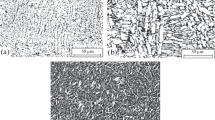Abstract
Some common features of the transgranular embrittlement of α-titanium alloys in chloride solutions, hot salts, liquid metals, and air are established. These types of brittle fracture are typical symptoms of trans-granular embrittlement along the basal (near-basal) cleavage planes of metals (alloys) with hcp crystal lattices with various values of the ratioc/a. In this connection, the role of alloying elements and the mechanism of corrosion cracking of α-titanium alloys in chloride solutions are reconsidered.
Similar content being viewed by others
References
R. K. Melekhov,Corrosion Cracking of Titanium and Aluminum Alloys [in Russian], Tekhnika, Kiev (1979).
M. I. Blackburn, I. A. Feeney, and T. R. Beck, “Stress-corrosion cracking of titanium alloys,”Adv. Cor. Sci. Tech.,3, 67–292 (1973).
L. A. Ivanova, A. I. Igolkin, and Yu. D. Khesin, “Anisotropy of the corrosion-mechanical strength of α-based titanium alloys,”Probl. Prochn., No. 12, 108–110 (1989).
S.P. Lynch, “Cleavage fracture in face-centered cubic metals,”Met. Sci.,15, 463–467 (1981).
Ya. I. Spas, I. N. Levina, G. V. Chumalo, and A. A. Trufanov, “Microfractographic features of the fracture of pseudo-α-titanium alloys caused by corrosion cracking in acid media,”Fiz.-Khim. Mekh. Mater.,25, No. 1, 63–67 (1989)
N. Paton, and A. R. Spurling, “Hydride habit plane in titanium-aluminum alloys,”Met. Trans.,7A, No. 11, 1769–1783 (1976).
I. W. Hall, “Basal and near basal hydrides in Ti-5 Al-2.5 Sn,”Met. Trans.,9A, No. 6, 815–820 (1978).
I. C. Scully and D. T. Powell, “The stress-corrosion cracking mechanism of α-titanium alloys at room temperature,”Cor. Sci,10, 719–731 (1970).
D. G. Westlake, “The habit planes of zirconium hydride in zirconium and zircalloy,”J. Nucl. Mat.,26, 208–216 (1968).
U. Zwicker,Titanium [Russian translation], Metallurgia, Moscow (1979).
A. I. Igolkin, “On some regularities of the influence of alloying elements on the decrease in the brittle fracture susceptibility of metal alloys,”Metalloved. Term. Obrab. Met., No. 4, 2–4 (1992).
A. A. Presnyakov,Cold Brittleness [in Russian], Nauka (Kazakh SSR), Alma-Ata (1967).
V. V. Popovych and I. H. Dmukhovs'ka,Liquid Metal Embrittlement of Strained Metals [in Russian], Preprint No. 69, Karpenko Physicomechanical Institute, Ukrainian Academy of Sciences, L'viv (1983).
R. E. Keag and D. R. G. Jones, “Analysis of frature caused by liquid metal embrittlement,”Fiz.-Khim. Mekh. Mater.,27, No. 5, 27–34 (1991).
P. A. Rebinder and E. D. Shchukin, “Surface phenomena in solid bodies subjected to strains and fracture,”Usp. Fiz. Nauk,108, No. 1, 3–42 (1972).
V. S. Sinyavskii (editor),Advances in Corrosion Science and Corrosion Protection [Russian translation], Metallurgiya, Moscow (1985).
Additional information
Central Scientific Research Institute of Structural Materials “Prometheus,” St. Petersburg. Translated from Fiziko-Khimicheskaya Mekhanika Materialov, Vol. 30, No. 1, pp. 75–77, January–February, 1994.
Rights and permissions
About this article
Cite this article
Igolkin, A.I. Some features of the transgranular embrittlement of α-titanium alloys under the influence of the environment. Mater Sci 30, 72–74 (1995). https://doi.org/10.1007/BF00559020
Received:
Issue Date:
DOI: https://doi.org/10.1007/BF00559020




